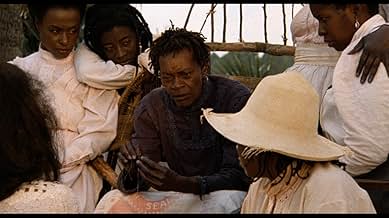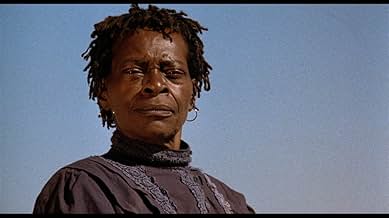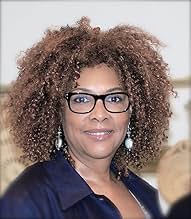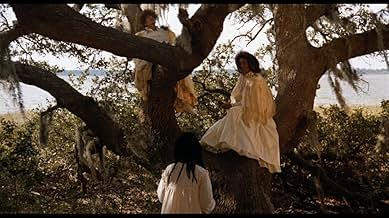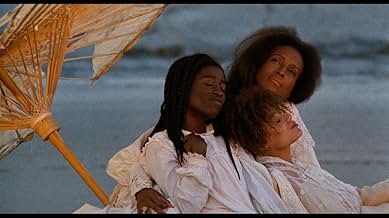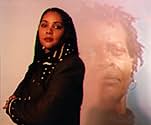Situado em 1902, dá uma olhada na cultura Gullah das ilhas do mar na costa da Carolina do Sul e da Geórgia, onde os costumes africanos permaneceram até o século XX e foi um dos últimos basti... Ler tudoSituado em 1902, dá uma olhada na cultura Gullah das ilhas do mar na costa da Carolina do Sul e da Geórgia, onde os costumes africanos permaneceram até o século XX e foi um dos últimos bastiões desses costumes em América.Situado em 1902, dá uma olhada na cultura Gullah das ilhas do mar na costa da Carolina do Sul e da Geórgia, onde os costumes africanos permaneceram até o século XX e foi um dos últimos bastiões desses costumes em América.
- Direção
- Roteirista
- Artistas
- Prêmios
- 4 vitórias e 2 indicações no total
- Yellow Mary
- (as Barbara-O)
- Newlywed Man
- (as Malik Farrakhan)
Avaliações em destaque
The film concerns itself with the Peazant family; proud members of Gullah creoles who originated from slaves traded along the remote islets of South Carolina and Georgia. Even before the Civil War generations of the Gullah people lived quietly as rice farmers on these islands and thanks in large part to regional isolation they were able to rebuild and retain much of the linguistic, cultural and religious heritage that had been wiped out by the slave trade. By 1901, the Peazants are mulling over the idea of relocating to the mainland.
The film has the narrative distinction of being told from the perspective of an unnamed and unborn member of the Peazants played by Kay-Lynn Warren. At only four, the young Warren peeks through the hole of her family's history only appearing twice herself as a sprite. We meet her pregnant mother Eula (Rogers), her aunts Haagar (Moore), Viola (Bruce) and Yellow Mary (Barbara-O) as well as Nana (Day) the matriarch of the family. Nana is old enough to remember the scourge of slavery and as a result is resonant to move to the mainland. Meanwhile Haagar is the strongest advocate for the move saying "If Nana wants to live and die on this island, then God bless her old soul." Two members of the clan have already moved away; Viola who moved to Philadelphia to become a ardent Christian; and Yellow Mary, who according to Viola is a "wasted woman".
Despite showcasing a family hungry for change and progress, the film gives proper reverence to the traditions of the Gullah people. The most respected people on the island are the elders who consist of Nana and Bilal Muhammad (Abdurrahman) the resident mullah. The spiritual ceremonies of the family relies on a mixture of Christianity, Islam and African animism that gives everything natural around them a lyrical quality. Yet underneath the pleasant depictions of sun-soaked beaches and marshy lowlands the internal conflict behind the eyes of the Peazants can't help but surface during communal gatherings. "We are two people in one body," says Nana as she defies the rest of the family who hope to travel north with their hopes and dreams.
If there is one glaring problem with Daughters of the Dust it's its expectations of the viewer. During production director Julie Dash wanted to keep the authenticity of the people intact and thus had actors speak only in the Gullah dialect and didn't consider subtitles. A minority of audience members may find this tact a mesmerizing exercise in linguistics. A feeling not unlike hearing the warm familiar sounds of your parents speaking while you were a toddler. From a purely anthropological perspective this was the best narrative choice one could hope for, allowing those with patience further rewards with repeated viewings. Unfortunately if you're not one of patience or a strong interest in anthropology or etymology you might find yourself distracted and looking for other stimuli.
There are many ways to read a movie of this nature. Most movies start and end with a graspable narrative, quick and easy explanations to plot details and an clear resolution. Daughters of the Dust doesn't let you off the hook with easy solutions. It instead asks serious questions. Questions that highlight the consequences of modernity's encroachment on tradition, cultural identity, cross-generational turmoil and diaspora. Furthermore the movie gives willing audiences a sense of belonging among the Gullah people; a warmth you seldom feel on the screen. It also does so in a very spirited and exquisite way featuring some of the most lyrical visual storytelling $800,000 can buy.
Julie Dash has chosen to share with her audience a chapter of black history that is still new to most white Americans, the internal issues that came with Black Americans as they made their way North in the years between 1900 and 1920. The separation from the soil, the divorce from those remnants of West African culture that survived through the holocaust of slavery. The psychic tearing of the transition from rural to urban culture. The skin game that Yellow Mary and other "fair skinned" Black people had to play in order to survive in White America. If the film is boring to many, let it be plainly said that it is boring for many because the film maker courageously chose to examine a piece of history that most White Americans- and many Black ones- no longer care much about.
If you want to be entertained, this isn't a film you'll enjoy. "Daughters of the Dust" offers instead an opportunity to probe deep, to look close at the dreamy quality of an internal life, and a balanced relationship with the earth, that most of our peoples in the United States have chosen to leave behind them for exactly the wrong reasons. Let those who have difficulty thinking about these things stick to action films. "Daughters of the Dust" is about something more akin to the sense of wonder that's being rapidly stamped out of many of us in the name of mom, apple pie, and the gross national product. It is worth not one, but many viewings. Julie Dash has created a masterpiece of American cinema.
Daughters of the Dust is a film written and directed by Julie Dash. It tells the story of a family of African-Americans who have lived for many years on a Southern offshore island, and of how they come together one day in 1902 to celebrate their ancestors before some of them leave for the North. The film is narrated by an unborn child, and ancestors already dead also seem to be as present as the living.
Julie Dash underwent many hardships in bringing the story to the silver screen. She had severe budget constraints, filmed in mosquito and insect infested areas, was delayed by Hurricane Hugo, sidetracked by sudden and violent sandstorms, and was forced to decide to either have a child or make the movie. In the end, she choose to give birth and nurture the story Daugthers of the Dust and the result is an unconventional masterpiece.
Initially, the response by white male critics was not favorable and they accused Dash of not adequately explaining the Gullah people, their culture, and their religious traditions. While attacking Dash, these critics failed to acknowledge many positive aspects of the film. The reasons behind this, according to Bell Hooks, is that "we've never been taught, most of us, in any history class that black people had different languages, had different religious practices, etc. So, to some extent, the film represents that challenge to a critic of any race" to review something they are not familiar with.
Because of these reviews and the fact that movie tells the story of African American women in an unconventional manner, it would seem to have slim commercial prospects. However, through word of mouth and some positive reviews it was able to generate a cult following. To date, the film has grossed 1.6 million from a budget of only 800,000.
The Newark Black Film Festival has chosen Daughters as the Film of The Century while the British Film Institute's Sight and Sound Magazine chose the soundtrack as one of the best in the past 25 years. It also received the Best Cinematography award at the Sundance Film Festival in 1991.
I believe the film hits the viewer on various levels. By placing the story in the early 1900's, Dash is able to show us a turbulent time for African-Americans and address many issues such as migration, lynching, and the changing African-American culture. Dash also shows and teaches us about Ibo culture and it's importance in the lives of those inhabiting the Sea Coast Islands, not just the African-Americans sharing the Gullah culture, but also the Native Americans, Muslims, and Christians.
Você sabia?
- CuriosidadesSelected to the Library of Congress National Registry of Film in 2004.
- Citações
[first lines]
Nana Peazant: I am the first and the last. I am the honored one and the scorned one. I am the whore and the holy one. I am the wife and the virgin. I am the barren one and many are my daughters. I am the silence that you can not understand. I am the utterance of my name.
Principais escolhas
- How long is Daughters of the Dust?Fornecido pela Alexa
Detalhes
- Data de lançamento
- Países de origem
- Idiomas
- Também conhecido como
- Daughters of the Dust
- Locações de filme
- Empresas de produção
- Consulte mais créditos da empresa na IMDbPro
Bilheteria
- Faturamento bruto nos EUA e Canadá
- US$ 1.683.422
- Fim de semana de estreia nos EUA e Canadá
- US$ 10.842
- 20 de nov. de 2016
- Faturamento bruto mundial
- US$ 1.689.776
- Tempo de duração
- 1 h 53 min(113 min)
- Cor
- Proporção
- 1.85 : 1






